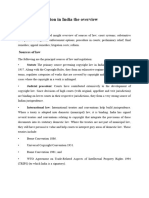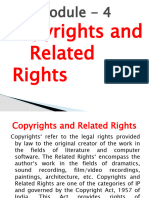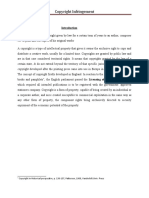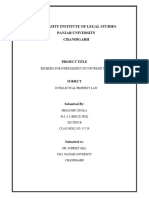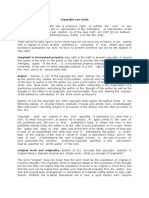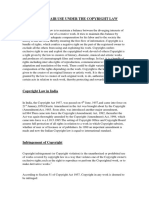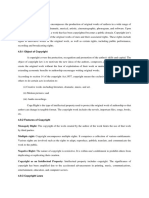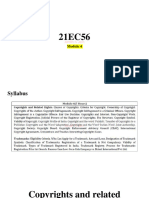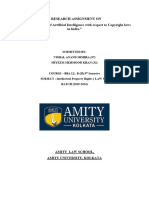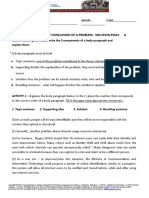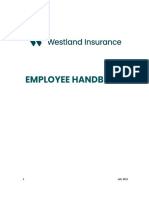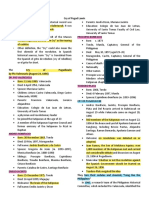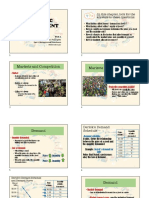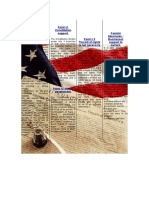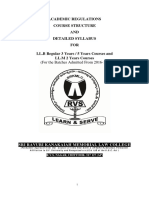Infringement of Copyright
Copyright infringement happens when someone uses a copyrighted work without permission in a
way that violates the rights of the copyright owner. These rights include copying, distributing,
performing, or adapting the work. The goal of copyright law is to protect the creator's intellectual
property while also ensuring that the public can access information and cultural works fairly.
When these rights are violated, it harms the creator financially and damages their reputation. It
also creates challenges for society in understanding the value of intellectual property.
The Indian Copyright Act, 1957, lays out rules to address copyright infringement, define what
counts as infringement, list exceptions, and describe penalties.
Legal Framework for Copyright Infringement
The Indian Copyright Act defines and addresses copyright infringement in detail. Section 51
explains that infringement happens when someone, without the copyright owner's permission,
does something that the owner has the exclusive right to do. This could be copying, distributing,
performing, or adapting the work. Even allowing a venue to be used for an illegal performance is
considered copyright infringement.
Some actions are exempted under Section 52. These include "fair dealing" for private study,
research, criticism, or review. Other exceptions are using materials in court or government
proceedings, making backup copies of software for educational purposes, and reproducing
content for teaching or exams.
Section 53:
This section addresses the importation of infringing copies. If a copyrighted work is imported
into India without proper authorization, it is considered an infringement.
The copyright owner can apply to customs authorities to seize the infringing copies at the border.
This provision is particularly effective in combating piracy and ensuring that illegal copies of
books, movies, music, and software do not enter the country.
Section 53A gives copyright owners the right to stop the import of pirated goods by asking
customs authorities to block them. Section 54 allows owners to seize and destroy infringing
copies or demand compensation. Section 52A ensures that sound recordings and video films
display copyright ownership details to prevent misuse.
Types of Copyright Infringement
Copyright infringement can happen in several ways:
Primary Infringement: This is a direct violation of the copyright owner's rights, like copying and
sharing a book, movie, or song without permission.
Secondary Infringement: This happens when someone helps or supports others in infringing
copyright, such as selling pirated copies or hosting illegal performances.
�Online Infringement: In the digital age, sharing copyrighted content on websites, social media, or
file-sharing platforms without permission is common.
Commercial Infringement: This involves using copyrighted works for profit, like selling fake
books or screening movies illegally.
Each of these harms the copyright owner by reducing their income and recognition.
Stages of Copyright Infringement
Dealing with copyright infringement involves several steps. First, the copyright owner identifies
the infringement, often with the help of monitoring agencies. Next, they send a cease-and-desist
notice to the violator, asking them to stop the illegal activity. If this doesn’t work, the owner can
take legal action by filing a case in court. Finally, the court may order the destruction of pirated
copies, payment of damages, or penalties like fines or imprisonment.
Advantages of Addressing Copyright Infringement
Protecting against copyright infringement has several benefits:
Encourages creativity: Protecting rights motivates creators to produce new work, leading to
cultural and intellectual growth.
Boosts the economy: It ensures creators and industries earn fair revenue from their creations.
Increases awareness: Enforcing copyright laws teaches people to respect intellectual property.
Preserves cultural heritage: Protecting works like literature and music ensures they remain
authentic and available for future generations.
Disadvantages of Copyright Laws
While copyright laws are essential, they also have some challenges:
Limited access: Strict enforcement can make important materials like books and software
expensive, especially for students and researchers in low-income areas.
High legal costs: Pursuing legal action can be costly and time-consuming, especially for small
creators.
Fair use confusion: The "fair use" concept is not always clear, leading to disagreements about
what is allowed.
Digital enforcement issues: The internet has made it harder to stop piracy, with websites and
platforms sharing content illegally and operating outside legal boundaries.
Plagiarism and copyright infringement are different, though both involve misuse of someone’s
work. Plagiarism means using someone’s ideas or work without giving credit, which is seen as
unethical, especially in academics or writing. Copyright infringement happens when someone
uses copyrighted work without the owner’s permission, even if credit is given. Plagiarism is about
honesty and doesn’t always break the law, while copyright infringement is a legal issue.
Plagiarism harms the creator’s reputation, while infringement affects their legal rights and
income. Both are wrong but are handled in different ways.
The Indian Copyright Act provides remedies for copyright infringement under Sections 55 to 62.
These remedies aim to protect the rights of the copyright owner and ensure justice.
�Section 55 gives the copyright owner the right to seek a civil suit for damages or an injunction to
stop the infringing activity. This section allows the owner to claim compensation for the loss
caused by the infringement.
Section 56 allows the copyright owner to take action in the case of "secondary infringement,"
where someone helps or encourages others to infringe the copyright. The owner can file a suit
against both the primary and secondary infringers.
Section 57 enables the copyright owner to stop further infringing activities by asking the court
for an injunction, which legally prohibits the infringer from continuing the activity.
Section 58 addresses the seizure and destruction of infringing copies. The copyright owner can
ask the court to seize and destroy the illegal copies of their work.
Section 59 grants the copyright owner the right to claim damages and profits earned by the
infringer due to the unlawful use of the copyrighted work.
Section 60 discusses the procedure for dealing with infringing goods that are imported into
India. The customs authorities can stop the import of pirated copies, and the owner can claim
the seized goods.
Section 61 focuses on the action the court can take in case of infringement. The court may order
the impounding of infringing copies and ensure they are handed over to the copyright owner for
disposal or destruction.
Section 62 allows for criminal prosecution in severe cases of copyright infringement, where the
infringer can be fined or imprisoned. This section aims to penalize those who deliberately break
the law for commercial gain.
These sections provide a way for the copyright owner to protect their work, claim damages, and
prevent further unauthorized use of their creations.
Conclusion
Copyright infringement is a serious issue that affects creators, industries, and society. The Indian
Copyright Act, 1957, provides a solid framework to tackle this problem, but the rise of digital
platforms has made enforcement more difficult. It is important to protect creators’ rights while
also ensuring the public has fair access to information and cultural resources. By respecting
intellectual property and encouraging ethical use of creative works, society can promote
innovation, preserve culture, and support a fair and thriving creative community.








